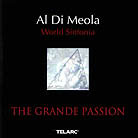November 2000
However, when I saw that three tracks were penned by Argentine tango legend Astor Piazzolla, I suspected The Grande Passion might be a keeper. DiMeola’s 1996 Plays Piazzolla is the only recording of his that has stayed in my collection over the years because it spoke my own idiosyncratic language. The Grande Passion hits me just as hard. When musical emotion, compositional substance, flawless delivery and unparalleled genius caress your cochlea as magically as they do here, ecstasy is the assured result. The Grande Passion brings us a new incarnation of DiMeola’s World Sinfonia ensemble, whose core members are percussionists Gumbi Ortiz from Cuba and Gilad from Israel, as well as Argentineans Hernan Romero and Mario Parmisano on acoustic guitar and piano. Parmisano, like Romero, participated on DiMeola’s previous albums Orange and Blue and Infinite Desire. Turkish percussion star Arto Tuncboyaciyan makes appearances on three tracks, and John Patitucci’s bass, Mike Mossman’s trumpet and Oscar Feldman’s tenor sax add heat and drive to a sensational track called "Asia de Cuba." DiMeola’s long-standing friendship and admiration for Astor Piazzolla are well-established. In fact, DiMeola has been on a confessed tango-esque mission ever since the Argentine bandoneon master died. The goal of successful discipleship is to imbue one’s work with the spirit of the master rather than degrading into a mere carbon copy. The Grande Passion is DiMeola’s tribute to a soul-friend and mentor. It is also a sovereign, self-assured statement about his successful assimilation of the Tango idiom. He embraces three famous Piazzolla works, "Double Concerto", "Soledad" and "Libertango" -- possibly Piazzolla’s most recognizable piece -- and actually reinvents them; he also fashions six other tunes that sound as though they could have been written by the master himself. The entire album combines the signature Piazzolla flourishes -- temperamental, angular, often-jagged melodies that fluctuate freely between pathos and despair, exuberance and anguish -- with a lushly symphonic romanticism that, on four tracks, literally turns orchestral through the cooperation of the Toronto Symphony. The seamless integration of neo-classical-, jazz-, and world-music-derived influences recalls electro-harpist Andreas Vollenweider as well as certain Secret Story compositions by Pat Metheny. Like the latter, far-ranging melodic arches and thematic development take unexpected detours. What struck me as overt technical showmanship and expansive but hard-to-follow stylistic experimentation in earlier DiMeola albums is replaced on The Grande Passion with a musical coherence that blends creativity and fret-board bravado. Following in the footsteps of Astor Piazzolla, Al DiMeola has, for me at least, found the master key to expressing his grand passion for music in a direct, uncomplicated way. Consider me caught -- hook, line and sinker. GO BACK TO: |
 Al DiMeola - The Grande Passion
Al DiMeola - The Grande Passion![[Reviewed on CD]](../format/regcd.gif) Al
DiMeola is one of the most honored guitarists in the world. Guitar Player has
nominated him Best Acoustic or Jazz Guitarist at least seven times. He won Honorary
Citizenship from the City of Atlanta. His albums Elegant Gipsy, Casino, Splendido
Hotel, Friday Night in San Francisco, World Sinfonia and Kiss My Axe all won
best-of-the-year honors from either Guitar Player or Record World. Such
global artistic recognition combined with his immaculate and astounding technique, have,
over the years, turned my failure to warm to so obviously gifted musician into an
immensely frustrating exercise of trial and error. For every "Mediterranean
Sundance" or "Oblivion," which I responded to, he’d produce ten
other songs I couldn’t relate to at all. This inability is obviously my own personal
peculiarity and not shared by guitar connoisseurs the world over. So, you can understand
my ambivalence at discovering his latest release, The Grande Passion, on my
to-be-reviewed pile.
Al
DiMeola is one of the most honored guitarists in the world. Guitar Player has
nominated him Best Acoustic or Jazz Guitarist at least seven times. He won Honorary
Citizenship from the City of Atlanta. His albums Elegant Gipsy, Casino, Splendido
Hotel, Friday Night in San Francisco, World Sinfonia and Kiss My Axe all won
best-of-the-year honors from either Guitar Player or Record World. Such
global artistic recognition combined with his immaculate and astounding technique, have,
over the years, turned my failure to warm to so obviously gifted musician into an
immensely frustrating exercise of trial and error. For every "Mediterranean
Sundance" or "Oblivion," which I responded to, he’d produce ten
other songs I couldn’t relate to at all. This inability is obviously my own personal
peculiarity and not shared by guitar connoisseurs the world over. So, you can understand
my ambivalence at discovering his latest release, The Grande Passion, on my
to-be-reviewed pile.